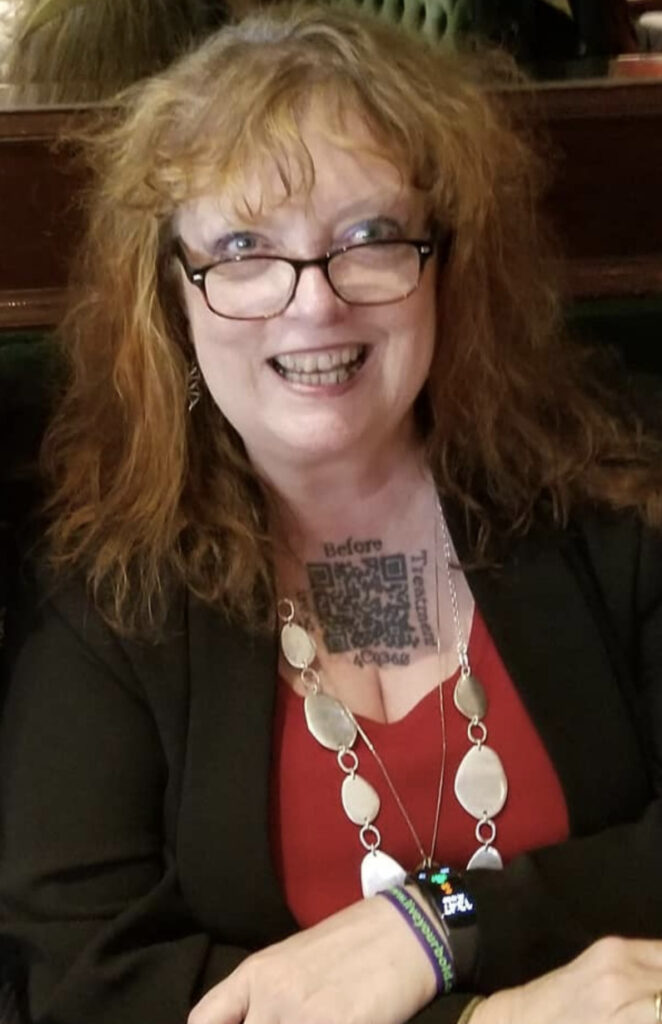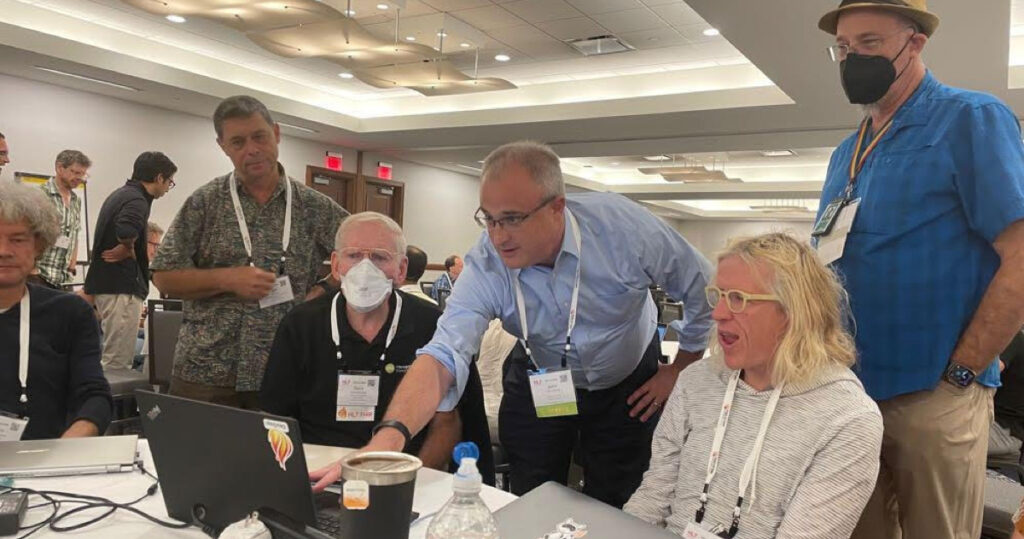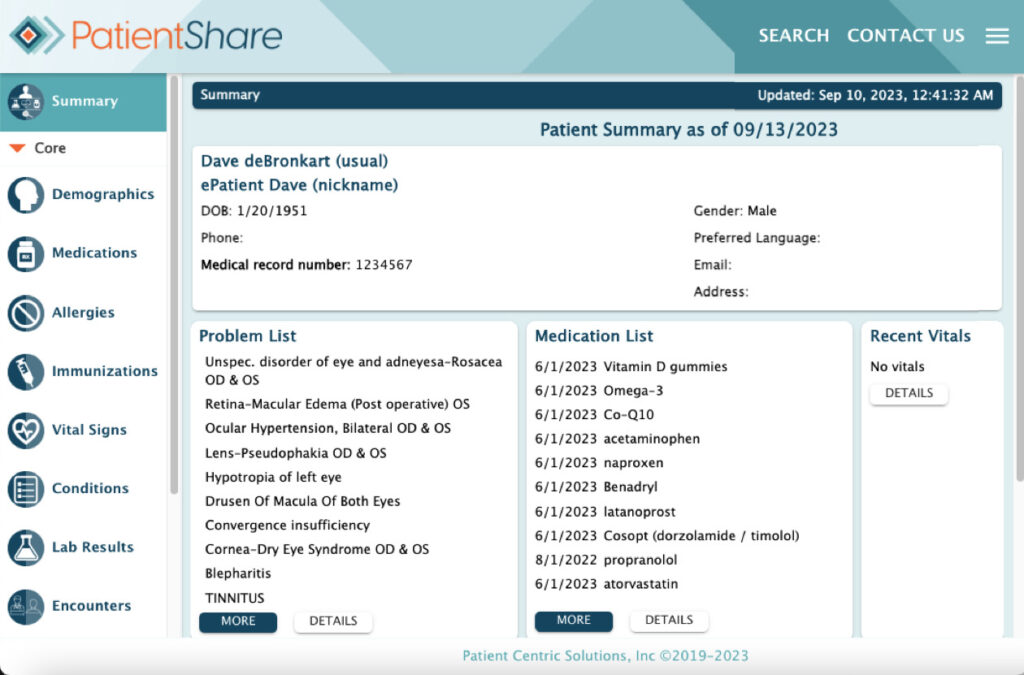
Regular readers know about “Mighty Casey” [left]: a very outspoken advocate for patient centered care who died in April. As her BMJ obituary said, she notoriously had a QR code tattooed onto her chest, linking to her complete medical history … because nobody in the health system could or would gather it all. So she did it herself. That’s an empowered patient!
Well, it got the attention of people working in FHIR health data standards. And this past weekend, at an event called a “Connectathon,” they hacked together a starter version of Casey’s dream.
Here’s the result – scan this QR code with your phone (or follow this link … same thing). It produces a human readable version of some of my own medical data.

The people who did this are working on a FHIR standard called IPS: International Patient Summary. There will be lots more to say about this later, but for now I want to acknowledge the work this weekend of the HL7 members who did this.
At this same meeting back in May, when I talked about Casey’s passing, they told me that an IPS contains exactly the kind of info Casey would have needed. Right then and there we got the idea for this, and I’m thrilled it’s already starting!

Again, this is just a start – a “proof of concept,” as they say. But what a GREAT start! And people are already full of ideas for next steps on expanding it into a more full-blown reality. Love it!
==========
Update Sept 13: same data in another viewer
One of the best things about data standards is that they let the data be used by anyone who wants to write software to do it. So it’s no surprise that within a day, while still at the meeting, I was approached by long-time colleague Nancy Lush, founder of Patient Centric Solutions. She and her team fed my same IPS file into their viewer, and voila! View it at this link.
For convenience I’ll also paste in a screen capture of the top part. See? It’s the same information, displayed in a different format.

Remember, by the way – although the IPS viewers shown here (my QR link, and the screen capture) are real products, my IPS data isn’t from a working product: it was hand-coded by people at the Connectathon, and then viewed by these different viewers. The point is that the work Casey demanded has begun … and believe me, I’ll keep you updated as important new developments arrive. :-)


Wonder to see what happens when we listen to patients!
not wow what about hacking and update the cons more than the pro
As with everything in digital security, whether to participate is a choice, right?
Another thing to realize is that all this could possibly do is pull together data that already exists digitally.
I personally fully support everyone’s individual choice on such things. Having said that, there are LOTS of cases where real harm is done by LACK of having all the information pulled together. See the Patient Impact Stories on Unblock Health, where people really suffered because important information was not available at the point of care https://www.unblock.health/patient-impact-stories/
Hacking what?
What do you mean by “update the cons”?
Seems pretty nice. The question to me is how is the information gathered and from what sources? Why are so many of the problems uncoded (and therefore not machine readable)? As you say, it’s a good start.
It is indeed just a proof of concept (POC)! Your questions, not surprisingly, fall under “much more to come.”
Why are some of the problems uncoded? For this demo/POC, they hand-coded everything, because the focus was on doing something using the International Patient Summary data format, so they cobbled an IPS together for me manually. Where they could find codes, they used them. Once this is a live workflow from FHIR endpoints, they’ll of course be coded.
They started with a list I published last year of all my conditions and medications, as shown in the EMR at the five places where I’ve received care in recent years. https://docs.google.com/spreadsheets/d/1xgNRhsWOKG4RkSu3LoaINA9GStmp9MmRxyci4dcvFB4/edit#gid=0
I had published it to begin a project of correcting all the inconsistencies between providers. That project never went anywhere but the list has been useful for discussions about many things, and turned out to be useful here.
Now, why aren’t many items machine readable? The #1 reason is that as we’ve discussed, my main provider, Beth Israel Deaconess :-), does not offer an API; they have decided not to do FHIR, and will be migrating to Epic, which I imagine will be live in some future year. So for any PHR that I might use until then, any data from BID will need to be hand entered. This is, as I’ve said many times, the legacy left behind by their longtime/former CIO: a homegrown system compatible with no standards, and thus offering no modern interop.
(For those new to the subject, I’ll note that through the years he blogged that he believes patients don’t want their data, so it’s not surprising that he’d see no need to support apps that empower patients.) https://www.epatientdave.com/2016/11/07/dear-john-i-want-to-download-my-records/
Anyway: the next step in this “Connectathon” starter project will be to add live feeds from the FHIR endpoints at Lahey and Mass General Brigham. That data will, by definition, be legit machine coded. Onward! :-)
From Amit Trivedi, Sr. Director – Informatics & Health IT Standards at HIMSS, on LinkedIn:
Amazing and timely work! Thank you all who supported this effort. Dave, with your permission I shared some of this recent progress at our @himss CIO Connect session today and folks were blown away.
Yes, this stuff *is* real! And they should be paying attention and get engaged.
Dave — I’ve been working on this problem for my own medical records and I don’t have a satisfactory solution. I’ve been gathering, and dispersing my records to multiple sources — in some situations, driving up to two hours to hand deliver CDs with MRIs on them. Oy! If you need a second individual with a ton of medical records (i.e. cancer survivor + part of a large longitudinal clinical trial with access to millions of data points) I’m your gal.
I feel your pain, Cheryl! I think we’re getting there, because of the mandate last year that holders of your records must make them accessible via FHIR. But the apps and workflows don’t yet exist that will enable it.
This is not that, though. An IPS is a simplified, shorter snapshot of your status at this moment in time, basically for the purpose of introducing you to a new doctor for treatment away from home. This LinkedIn post by one of the IPS spec authors may be useful: https://www.linkedin.com/feed/update/urn:li:activity:7107111590289629184/
I should note, too, that radiology images are not required to be included, though I believe that question is under considering for the next edition of USCDI, which is the list of what must be included.